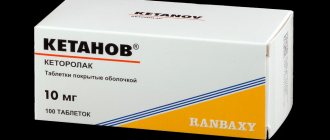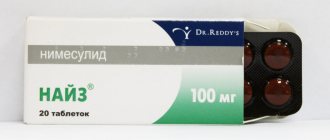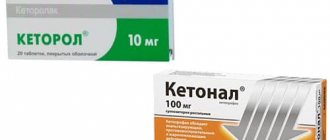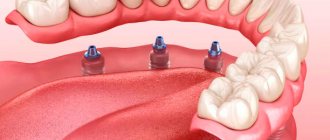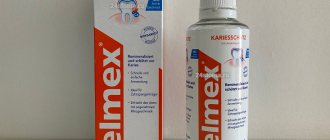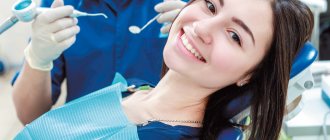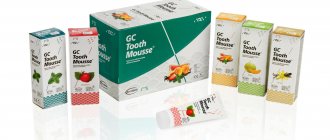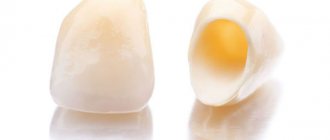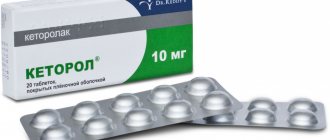Updated: 04/23/2021 15:12:56
Expert: Abramova Tsilya
| Nise | |
| Advantages | Flaws |
| Complex action – reduces temperature, relieves pain, removes inflammation, thins the blood | May be ineffective for severe pain |
| Has many indications for use | |
| Available in several forms | |
| There is a suspension specifically for children | |
| Helps with acute pain syndrome | Tablets should not be used under 12 years of age |
| Ketonal | |
| Advantages | Flaws |
| Stronger analgesic effect, effective for severe pain | More contraindications |
| Many release forms | Cost is higher |
| Injections help quickly relieve acute pain syndrome | Does not apply to children under 14 years of age |
| Starts to act quickly | Higher risk of gastrointestinal adverse reactions |
| The effect lasts for a long time | |
Comparison of the effectiveness of Nise and Ketonal
The effectiveness of Nise is quite similar to Ketonal - this means that the ability of the drug substance to provide the maximum possible effect is similar.
For example, if the therapeutic effect of Nise is more pronounced, then using Ketonal even in large doses will not achieve this effect.
Also, the speed of therapy - an indicator of the speed of therapeutic action - is approximately the same for Nise and Ketonal. And bioavailability, that is, the amount of a drug reaching its site of action in the body, is similar. The higher the bioavailability, the less it will be lost during absorption and use by the body.
Comparison of safety of Nise and Ketonal
The safety of a drug includes many factors.
At the same time, in Nise it is quite similar to Ketonal. It is important where the drug is metabolized: drugs are excreted from the body either unchanged or in the form of products of their biochemical transformations. Metabolism occurs spontaneously, but most often involves major organs such as the liver, kidneys, lungs, skin, brain and others. When assessing metabolism in Nise, as well as in Ketonal, we look at which organ is the metabolizing organ and how critical the effect on it is.
The risk-benefit ratio is when the prescription of a drug is undesirable, but justified under certain conditions and circumstances, with the obligatory observance of caution in use. At the same time, Nise does not have any risks when used, just like Ketonal.
Also, when calculating safety, it is taken into account whether only allergic reactions occur or possible dysfunction of the main organs. In other matters, as well as the reversibility of the consequences of using Nise and Ketonal.
What is the difference between nonsteroidal anti-inflammatory ointments, creams, and gels?
Home / About the problem / What is the difference between non-steroidal anti-inflammatory ointments, creams, gels
Where does it hurt?
Inflammatory diseases of the musculoskeletal system, for example, arthritis, myositis, osteochondrosis, as well as injuries, including sports and household injuries, such as sprains or bruises, are often accompanied by severe pain and swelling. Therefore, complex therapy usually includes external non-steroidal anti-inflammatory drugs in different release forms. Such drugs help relieve pain, and also help relieve swelling and erythema by suppressing the formation of prostaglandins - substances that contribute to the development of the inflammatory process1. Usually these are gels, ointments and creams, which differ from each other not only in the active substance, but also in the composition of the auxiliary components and the consistency of the base. Their use allows for maximum concentration of the drug in the area of application2.
To make ointments, chemically neutral, soft, fatty and dense substances that do not penetrate the skin well are used as a base. Creams have an emulsion base, lighter in consistency than ointment. Thanks to this, they leave only a slight fatty trace on the skin. Gels are gelatinous dosage forms produced on hydrophilic, that is, aqueous, bases3.
To determine which ointment or gel is better suited for use in a particular case, it is necessary to take into account the specifics of the damage. For example, ointments are used for chronic processes or when there is dryness, scales or crusts on the affected area. The fatty base of the ointment softens the stratum corneum, increasing its permeability to the active substance4. However, they are difficult to apply daily, as they leave a greasy and sticky residue on the surface that does not dry out.
Aertal® cream is a non-steroidal anti-inflammatory drug based on aceclofenac, which has anti-inflammatory and analgesic effects. The concentration of the active substance in it is 1.5%, while it is in the cream in micronized form. The base of Aertal® cream includes emulsion wax and liquid paraffin, as well as some other excipients.
Emulsion wax and liquid paraffin, which form the basis of Airtal® cream, are substances widely used in the pharmaceutical and cosmetic industries. They improve the consistency of the cream and facilitate uniform absorption of the active substance. At the same time, emulsion wax moisturizes and nourishes the skin, but does not leave a greasy mark on it5. This property allows you to use anti-inflammatory creams based on it daily. In addition, the cream, unlike the gel, allows you to retain the active substance in the painful area for a longer time.
When using Aertal® cream, aceclofenac practically does not enter the systemic circulation, and therefore the risk of systemic side effects, including on the gastrointestinal tract, is minimized6.
Airtal® cream should be applied to the painful area three times a day, using gentle massage movements. The application dose is determined by the size of the affected area, and it should be taken into account that 1.5–2 g of cream corresponds to a strip of 5–7 cm.
1 Kukes V.G. Clinical pharmacology. 2006. pp. 534–543.
2 Gavrilov A. S. Pharmaceutical technology. Manufacturing of medicines: textbook / A. S. Gavrilov. M.: GEOTAR - Media, 2010.
3 Krasnyuk I.I.. Pharmaceutical technology: Technology of dosage forms: Textbook for students. avg. prof. schools, institutions. - M.: “Academy”, 2004.
4 Dermatovenereology: textbook for medical universities / A. V. Samtsov, V. V. Barbinov.-SPb. : SpetsLit, 2008.
5 Kunder E. V. Analgesic therapy of inflammatory and degenerative joint diseases // International reviews: clinical practice and health. 2015. No. 1 (13). Ss. 56–63.
6 AIRTAL® (AIRTAL®) instructions for use.
About the cream
Airtal® cream has anti-inflammatory, analgesic and anti-edematous effects.
Injuries
Country injuries: protective measures and first aid
Chronic pain
Back pain: causes and treatment
Comparison of addiction between Nise and Ketonal
Like safety, addiction also involves many factors that must be considered when evaluating a drug.
So, the totality of the values of such parameters as “o syndrome” in Nise is quite similar to the similar values in Ketonal. Withdrawal syndrome is a pathological condition that occurs after the cessation of intake of addictive or dependent substances into the body. And resistance is understood as initial immunity to a drug; in this it differs from addiction, when immunity to a drug develops over a certain period of time. The presence of resistance can only be stated if an attempt has been made to increase the dose of the drug to the maximum possible. At the same time, Nise’s syndrome values are quite small, just like Ketonal’s.
Description of Nise
The drug based on nimesulide is produced by Dr. Reddy's Laboratories in India. Has anti-inflammatory, analgesic and antipyretic effects. The drug is sold in the form of tablets, gel, solution. For some pathologies, several forms of medication can be used at once to increase the therapeutic effect.
In addition to its anti-inflammatory effect, Nise has the ability to reduce blood clots. It prevents the adhesion of blood clots and thins the blood. However, the medicine is not used as an independent remedy for the treatment of thrombocytosis, since its main effect is aimed at relieving symptoms of inflammatory diseases.
Research and effectiveness
Nise is an effective painkiller that is convenient to take for quick pain relief. The low risk of adverse reactions makes this drug one of the most effective of the NSAID group.
In the Russian Federation, Nise is one of the most widely used NSAIDs. It has a rapid analgesic effect and is well tolerated by patients. During the 15-year period of use of the drug, many studies were conducted that showed its effectiveness and good tolerability. In addition, it is characterized by low cost and availability.
Sources:
- Grechenkov A.S. "Nimesulide as a drug of choice for the treatment of pain in outpatient practice." 2021.
- Kerateev A.E. "Nimesulide: advantages outweigh disadvantages." 2012.
Contraindications
The medicine Nise has a considerable list of contraindications:
- hypersensitivity to the composition;
- excess potassium in the body;
- polliposis, bronchial asthma, intolerance to acetylsalicylic acid;
- renal failure;
- ulcerative and erosive processes in the mucous membrane of the stomach and duodenum;
- ulcerative colitis, Crohn's disease;
- a history of hepatotoxic reactions to the use of nimesulide;
- alcohol and drug addiction;
- blood clotting disorder;
- decompensated heart failure;
- active liver disease;
- pregnancy, breastfeeding;
- in pediatrics.
The drug is prescribed with caution for coronary artery disease, congestive heart failure, diabetes mellitus, and arterial disease. In old age, dose adjustment may be required. Drug interactions should be considered. You should not combine Nise with drugs that are potentially toxic to the liver.
Side effects
The following side symptoms are possible from using Nise:
- allergies – hypersensitivity, anaphylaxis;
- high blood pressure, hot flashes, tachycardia, hemorrhage;
- visual impairment;
- dizziness, anxiety, fear, nervousness, nightmares, drowsiness;
- increased levels of transaminases, cholestasis, hepatitis, jaundice;
- nausea, diarrhea, constipation, bloating, stomatitis, abdominal pain, bleeding;
- thrombocytopenia, anemia, pancytopenia;
- rash, itching, erythema, dermatitis, facial swelling, epidermal necrolysis;
- urinary retention, edema, hematuria, renal failure, nephritis;
- shortness of breath, exacerbation of bronchial asthma.
Dosage
Nise is best taken after meals. A minimum dose of the drug is used in a short course. After 12 years and adults, 1 tablet 2 times is recommended. The maximum dose is 200 mg. In case of chronic renal failure, the dose is reduced to 100 mg.
In case of overdose, nausea, vomiting, apathy, and drowsiness are noted. The consequences are reversible with prompt assistance to the victim. There is a risk of developing gastric bleeding and a sharp increase in blood pressure, respiratory depression and the development of renal failure are also possible.
In case of overdose, symptomatic treatment is carried out. The stomach is washed and an enterosorbent is prescribed. Laxatives may also be used.
Who is it suitable for?
The medicine Nise has the following indications:
- exacerbation of gout;
- rheumatoid arthritis;
- articular syndrome;
- osteoarthritis;
- inflammation of the tissues of the musculoskeletal system;
- non-rheumatic and rheumatic myalgia;
- pain syndrome of various origins;
- spondyloarthritis;
- osteochondrosis.
Nise is often used in dentistry to eliminate dentalgia and relieve pain after surgery. It is also indicated for one-time use for headaches.
Comparison of side effects of Nise and Ketonal
Side effects or adverse events are any adverse medical event that occurs in a subject after administration of a drug.
Ketonal has more side effects than Nise. This implies that the frequency of their occurrence is low in Ketonal and low in Nise. Frequency of manifestation is an indicator of how many cases of an undesirable effect from treatment are possible and registered. The undesirable effect on the body, the strength of influence and the toxic effect of drugs are different: how quickly the body recovers after taking it and whether it recovers at all. When using Ketonal, the body's ability to recover faster is higher than that of Nise.
